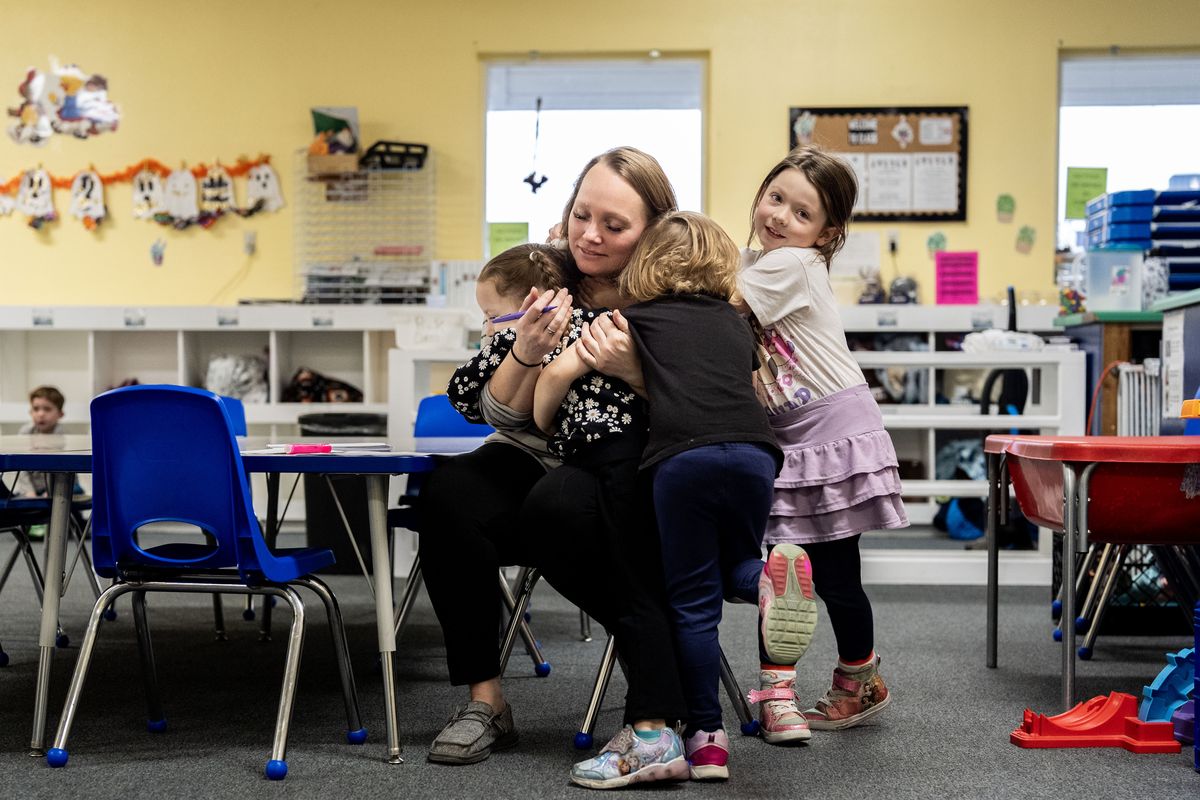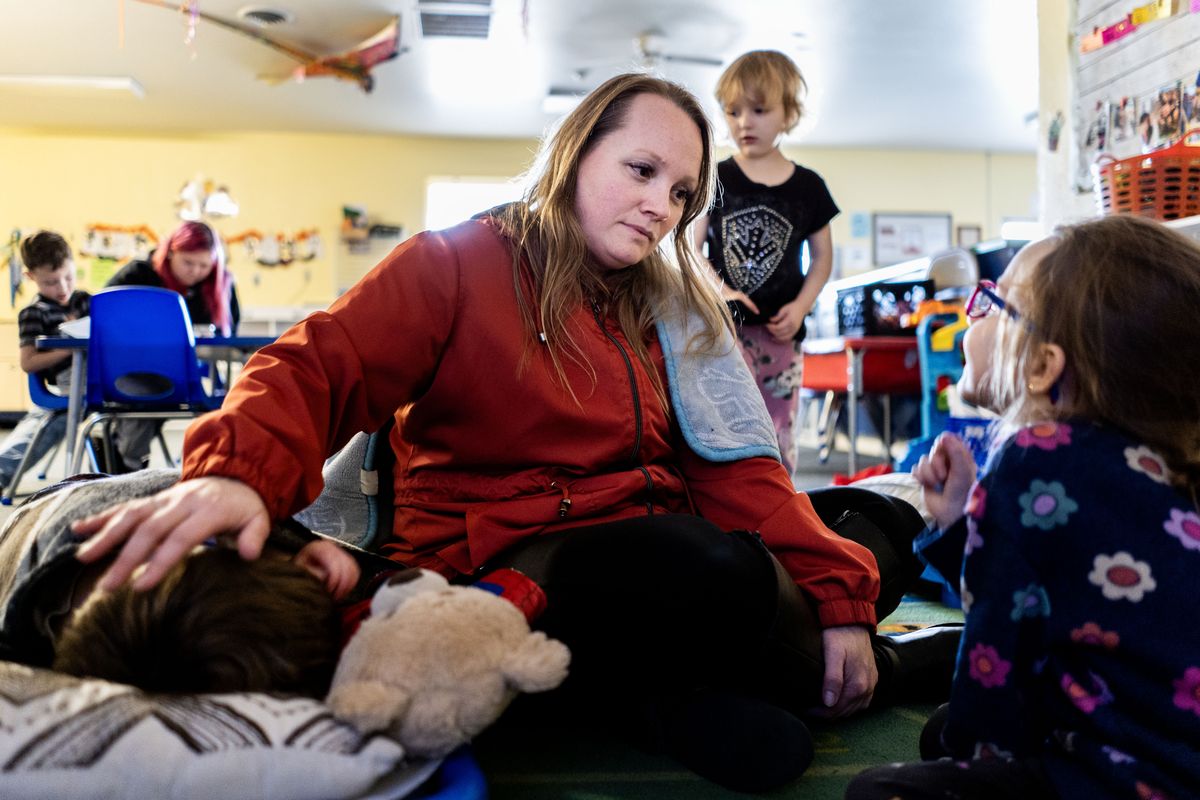Child care gets little help in Idaho. A family-run center is buckling
Krystal McFarlane tries to helps one child fall asleep during nap time while listening to a little girl named Regan at TLC for Tots day care in Nampa, Idaho. (Melina Mara/The Washington Post)
NAMPA, Idaho – Payday was coming and the day care’s bank account was dangerously low, so Krystal McFarlane again went outside to check TLC for Tots’ black mailbox. She hoped to find the payment that one toddler’s dad kept promising would arrive. She returned with empty hands and a sigh.
“It’s the 15th and we still don’t have it,” McFarlane told her assistant over the tiny voices of children eating generic Cheerios at pint-size tables. She sat at a front desk piled with estimates for painting the center’s weathered exterior, a bill for the printer, a rent check that TLC was paying late for the first time in 16 years and a computer loaded with figures revealing the “hit after hit after hit” that McFarlane worried might soon force her to close.
Running the day care had never been easy or lucrative. Now the whole situation felt utterly broken.
The federal funds that helped businesses like TLC stay afloat during the pandemic – with grants and pay boosts – had expired in 2023, cut off early by Idaho’s conservative legislature. But the staff still expected the higher salaries, which at around $14 an hour was not close to a living wage. Costs of insurance and supplies like plastic gloves and canned vegetables kept climbing. And parents were struggling even more to afford the care.
Things only got worse this summer. The state, facing higher than expected demand and costs, abruptly stopped accepting most new applications in its federally funded child subsidy program for low-income families. Here in Nampa, a heavily agricultural city of about 114,000 west of Boise, half of TLC’s families relied on it.
So in August, when TLC would usually be welcoming, even wait-listing, new kids as school started, it instead had zero new enrollments. On the busiest days just a few months earlier, 75 children had attended; now just 43 did. In September, income was 22% lower than in June. In early October, McFarlane let three of her 16 teachers go amid fears that the fragile scaffolding beneath TLC might buckle.
“It feels like the beginning of the end, if I’m being honest,” she said.
McFarlane describes herself as conservative, skeptical of handouts. Even so, she was sometimes shocked by Idaho’s legislature. The lawmakers seemed to view child care – and helping working families afford it – as “left ideology,” she said, despite the presidential campaigns of both Donald Trump and Kamala Harris talking about the need for government solutions.
“Their ideal family is very quote-unquote traditional. And it really overlooks the reality of a lot of families’ real situations,” she said.
Others have drawn similar conclusions, with a recent study finding that Idaho, which has one of the nation’s most restrictive abortion laws, offers the fewest social services for women and children of any state with an abortion ban.
Idaho’s Republican leaders celebrated when the Supreme Court overturned Roe v. Wade in 2022, though Gov. Brad Little did say the ruling meant the deep-red state “must confront what we know will be growing needs for women and families.”
Yet Idaho backslid, allowing its maternal mortality review committee to disband and declining to expand postpartum Medicaid coverage before reversing both decisions this year. Amid a child-care crisis that is nationwide – with too few spots in some places and steep fees nearly everywhere – it remains one of a handful of states that spend no state dollars on child care. State law bars public schools from spending state money on prekindergarten students.
Three years ago, Idaho won an $18 million federal grant for preschool development. Little and the state’s U.S. senators hailed the news, as did business leaders, citing a U.S. Chamber of Commerce Foundation report that estimated “child care breakdowns” were costing Idaho $479 million annually in lost tax revenue and employee absences and turnover.
Legislators rejected the grant. Among their concerns: that the Idaho Association for the Education of Young Children, the nonprofit chosen to administer it, would teach concepts of social justice – an assertion the IAEYC denied.
State Rep. Charlie Shepherd, whose district is in rural northwestern Idaho, also raised a separate issue during debate. “Any bill that makes it easier or more convenient for mothers to come out of the home and let somebody else raise their child, I just don’t think that’s a good direction for us to be going,” he said. He later apologized.
During the 2024 session, a modest bill was introduced to create an Office of Early Childhood. Its GOP sponsor emphasized that the measure aimed only to integrate existing services to improve families’ access. The president of an influential conservative lobbying group, the Idaho Freedom Foundation, countered that the idea “dips us into ‘The Communist Manifesto.’ ”
“None of this is within the proper role of government. These services properly belong with families, with markets, with churches, with private volunteer organizations,” testified Ronald Nate, a former Republican legislator. While a House committee approved the bill, it never reached the full chamber.
For most of her life, McFarlane was uninterested in politics. But in the past few years, she had joined the IAEYC board and even met with officials in Boise and lawmakers in Washington to stress the industry’s woes. Some sounded sympathetic. Others suggested providers were bad at business or swimming in cash given their $800-a-month fees.
For TLC, McFarlane insisted, neither was true. But here she stood at the day care’s front counter, folding cot sheets and towels that she had washed at home because the center’s machine was broken. A little girl with blond braids marched up.
“Huggy!” the child said.
“Of course!” McFarlane responded cheerily, bending to embrace her. “I needed that. How did you know?”
McFarlane’s parents started TLC as an in-home day care in 2006. Within two years, they signed a lease for a vacant produce market. Her father painted the center’s sign, yellow with a rainbow, in his living room. His goal, David Fetzer said, was to be “one of the best day cares in Nampa.”
Soon they had a waiting list and teachers who, for a long time, seemed OK with pay close to Idaho’s $7.25 minimum wage.
The location was never ideal. The low-slung building stands against a retaining wall and shares a lot with a big-box farm supply store. The carpets are worn and the playground is a small patch under a sunshade.
But TLC gained the trust of many families, and McFarlane proudly calls it a “learning center,” with weekly lesson themes like “apples” and “transportation and roads.” Cameras in the classrooms allow parents to watch their kids remotely.
COVID turned everything upside down. Her insurer stopped covering day cares; its replacement policy cost far more. To save on printing, McFarlane digitized enrollment forms. To save on staffing costs, she changed closing time from 7 p.m. to 6 p.m., thanking families in an email for their patience “as we navigate these challenges together.” She raised tuition, modestly.
She worried constantly about retaining her teachers. Even with the increased salaries, some qualify today for Medicaid. Others are able to work only because their kids can attend free.
McFarlane had so far refused to increase child-teacher ratios, which the state recently allowed to address shortages that put 50% of Idahoans in a “child care desert.” She viewed the change as a compromise on quality.
She regularly checks Facebook. Midway through a quiet Tuesday, the scent of lunch’s cheesy burger bake wafting from the kitchen, she saw in a private group for child-care providers that some were selling furniture and others their business. In a private group for local moms, some had posted about the Idaho Child Care Program subsidies.
“Even with ICCP, I’m still looking at over $1,300 for my kids per month. I literally won’t even have that much after bills are paid,” one woman wrote.
McFarlane, a single mother with a third-grader and a teen, understood the anxiety. “Most people are surviving off the hope and pray plan right now,” she said.
She picked up the phone to try reaching someone who had emailed about a spot for their child. No answer, so she left a message: “If you have any questions or if you’re ready to set up a tour, you can call me.”
She later made another call, this time to a parent who had recently withdrawn her three children after the child-care subsidy she depended on did not come through. She owed TLC more than $3,000.
“As long as I get some payment by the end of the month, I can keep it out of collections,” McFarlane told her.
Hanging up, McFarlane turned to Amillea Eccles, her assistant director, to relay that the parent had promised to pay a few hundred dollars a month until her tax return came in the spring. But what she’d really hoped – the subsidy was resolved and the kids would re-enroll – was not happening.
The money was owed by Sandy Letsom, a public high school teacher whose children had attended TLC since 2021. Her 4-year-old is autistic, and her 2-year-old has various feeding therapy protocols, and she had found the teachers met their needs better than other day cares she’d tried. She loved TLC’s warmth.
Her husband works low-wage hourly jobs, and the state subsidy dropped the family’s total day care fee to about $750 monthly. When summer came and Letsom could care for the two kids and their 3-year-old sibling, she pulled them out. She brought them back to TLC in August, and she was in the process of again applying for the subsidy when the state announced it would pause new enrollments in two days.
She missed the deadline. Full-price day care would now consume more than half of her $2,800 monthly take-home pay. “And the other half of my paycheck would maybe be rent,” Letsom, 26, explained in mid-October. “I would have nothing for gas or groceries.”
The Idaho Department of Health and Welfare’s abrupt change to the program, which at the time reached about 7,800 children, sent shock waves through the day-care community.
Emily Allen, who had toiled for years in the inhospitable trenches of child care advocacy at the capitol, was stunned. A policy associate at Idaho Voices for Children, she saw the early childhood bill that passed through committee in the spring as “a paradigm shift” – lawmakers were open to discussing the topic. At the ribbon-cutting of a day care that Micron Technology opened for employees in Boise, the governor identified investments in child care as “critical” for drawing workers to Idaho.
“It’s antithetical to all the momentum,” Allen said of the agency’s action. “It feels punitive, like they don’t care about child care, and they’re not listening, and they’re just walking back everything that was accomplished in the last couple years.”
Letsom’s husband ended up staying home with their children. Other parents made different calculations and decisions.
Kierra Larson works for a cleaning company in nearby Caldwell. Her older children, ages 1 and 3, were at TLC until she switched to a slightly cheaper Nampa day care. Her baby, born in August, now came with her to the office – thanks to a boss helping her save on child care costs.
Larson also saved by making only $15 an hour. The boss offered more, but the extra money would make her ineligible for the state subsidy, which is based on household income relative to the federal poverty level. She’d recently lost food stamps because her kids’ father, whom she describes as a good dad but an unreliable partner, began paying child support.
“In a perfect world, I want to be able to take care of me and my kids without any help,” Larson, 28, said this fall.
Early in her last pregnancy, unsure how she would support a third child, she made an appointment for an abortion in Oregon. She missed the appointment after she couldn’t come up with the $700 fee.
She felt guilty thinking of that call as she held the cherub she’d named Kamari. Yet life was constant scrimping. Her toddler daughter’s princess bed was a donation. Her toddler son’s racecar bed came from Facebook Marketplace. Her tidy apartment, which rents for $1,000 a month, is in the kind of dicey area where probation officers routinely visit.
As a child, she heard Idaho touted as “a moms’ state.” It did not feel like that to her now.
“It just feels like we’re kind of on the back burner,” Larson said. “It feels like this push of, ‘We want people to have kids and have families, but we won’t offer support.’ ”
The next day, McFarlane returned from the mailbox with an envelope. The letter was from the state about one family’s subsidy rate.
“Not the check we need,” she told Eccles.
It was billing day, when McFarlane would calculate what families owed, send out invoices and get a better sense of the month’s income.
“Now I hit my total,” she said, clicking on a spreadsheet on her computer and inhaling nervously.
A moment later: “That’s even lower than I thought.”
The decrease in ICCP payments from the state was part of the drop. They had fallen from $15,000 in June to $8,749 in October.
McFarlane was already offering her teachers voluntary time off, and she hated to think that she might have to let more go. Even with low enrollment, there were limits to how low staffing could be. Every day was a juggle to make sure child-teacher ratios were right – not just for legal reasons, but because bigger classes were a recipe for staff burnout.
The classroom for 1-year-old “wobblers” had a ratio of six children to one teacher, but often seven tots were present, and that meant two teachers were required. On this afternoon, just five were there, so lead teacher McKenna Rich was on her own for snack time. The vibe was something like a circus.
A bouncy rendition of “If You’re Happy and You Know It” streamed from a speaker. One boy gnawed on a board book. Another ambled in one shoe. Rich, a sunny 25-year-old with a long braid, was changing another diaper. “My wrists are so sore from changing so many,” she said.
The next half-hour was a whirlwind. “Soft hands!” she exhorted one little girl who had just hit a boy with a block. Rich’s own daughter was in the preschool classroom, the perk that made it possible for her to work at TLC and save some of her $2,200-a-month salary. She and her husband wanted to buy a house, but prices “are crazy.”
Out front, McFarlane was talking with a young man in a baseball cap, the dad whose $1,199 tuition check she’d been expecting earlier in the week. It was supposed to have been sent by his employer – an increasingly common arrangement in a market where workers are in demand.
“I feel terrible,” he said.
His toddler was new to TLC, and she wanted to be understanding. But if she didn’t have the money in five days, she said, the boy couldn’t stay.
McFarlane soon got diverted by a text from a veteran teacher, who was eight months pregnant and suddenly in the hospital because of high blood pressure. Maybe there was a way for the center to make do on fewer staff hours, she wondered.
She had other ideas, too, and she floated them by her father when he stopped by the next day to pick up her 15-year-old son to go hunting. Fetzer wore a camo jacket and a baseball cap that read “We The People.”
She first told him about the payment arrangement with Letsom. “That’s reasonable,” he said.
And what about opening half an hour later to save on salaries? “Sure, why not?” he agreed.
Fetzer still controlled TLC’s finances, but he’d long relied on his daughter to run things. They’d had a “mutual goal” when they started improving the day care every month. Now it felt like they were always cutting.
On the wall calendar behind McFarlane, “$ pay day” was written in green. Four days from now, she would learn whether TLC had enough money to cover wages without Fetzer dipping into savings.
He felt fairly confident they could make it to spring and what’s often an enrollment bump. His daughter wasn’t so sure. Much hinged on whether Idaho’s subsidy program resumed and in what form.
A few weeks later, officials announced a lower, pre-pandemic poverty rate for the subsidies. “We have some families that maybe barely are at that threshold,” McFarlane said. “It’s going to drop them off the program completely.”
At least the state would be restarting new enrollments in January. It was a bit of good news – but hardly enough to guarantee TLC’s future.















